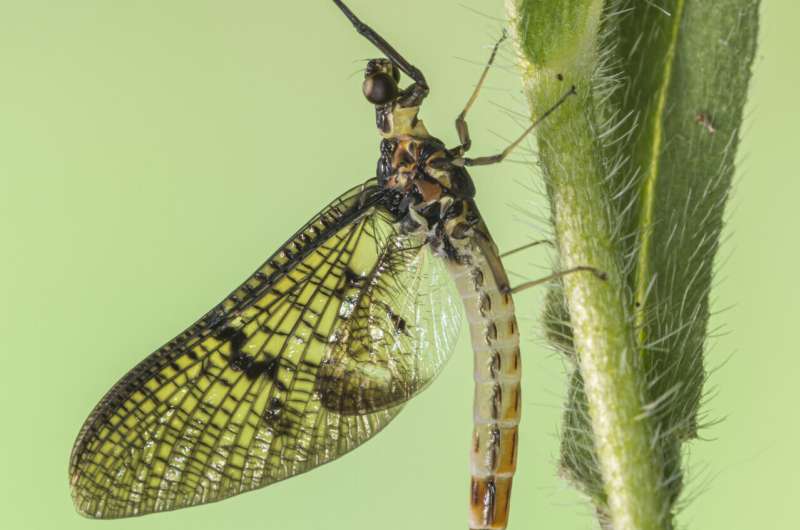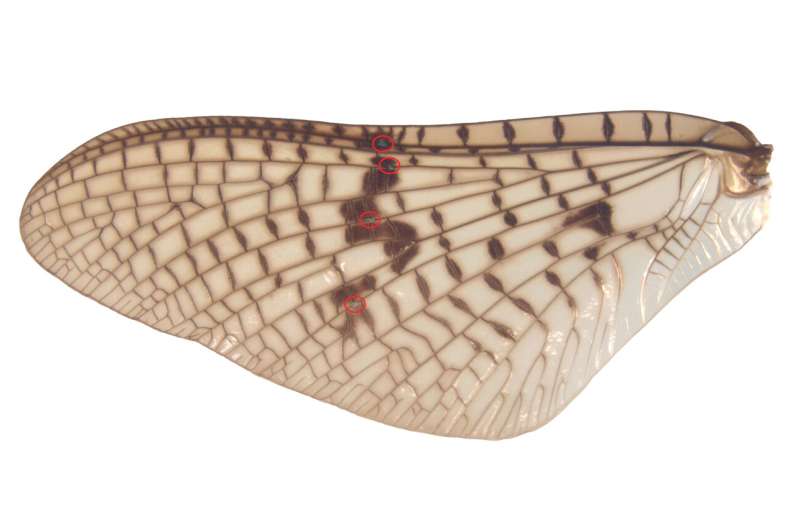This article has been reviewed according to Science X's editorial process and policies. Editors have highlighted the following attributes while ensuring the content's credibility:
fact-checked
peer-reviewed publication
trusted source
proofread
Wing characteristics of primitive insects unraveled

Mayflies are ancient insects that possess a unique life stage not found in other winged insects: Their fully-grown nymphs develop into a winged subadult stage, the so-called subimago, which is not yet capable of reproduction and which, after a short time, sheds its skin along with its wings to become an adult insect.
An international team led by Dr. Arnold Staniczek, an insect specialist at the Natural History Museum in Stuttgart, used modern technologies to discover and describe a key mechanism in the molting process from subadult to adult.
Some of the wing veins in mayflies include bubble-shaped areas named "bullae." The team's investigations revealed that these bubbles in the wings of mayflies do not play a role in flight, as previously assumed, but are crucial for molting into the final adult stage. The results, published in the journal BMC Biology, also provide clues about the evolution of winged insects.
Modern technologies help analyze wing structures
For 70 years, it was believed that the bullae in the wing veins of mayflies played an essential function in the flight of these ancient insects through passive downward bending of the outer part of the wing during upstroke, thus offering less air resistance and enabling the wing to lift more easily. This theory has now been overturned by the authors using modern research methods.
"When we took high-speed videos of mayflies in flight, we soon realized that the previous theory could not be upheld: Instead of the wings bending during upstroke, they are simply held vertically to avoid air resistance, but the wing itself remains stable," says Dr. Staniczek.
The wing bullae and their detailed structure were investigated using scanning electron microscopy, synchrotron micro-CT, and fluorescence microscopy, which confirmed that the bullae are in fact membranous weak points in the wings of both winged stages of these insects.
When filming the molting of subadults to adults, the researchers observed that "in order to pull out the new wings from the cast-off skin, the mayflies lift their wings, bending them at the defined weak points to more easily extract them undamaged. We do a similar thing when bending our arms to take off a jumper more easily," says Staniczek. This hypothesis was also indirectly confirmed by the observation that bullae are missing in those few mayflies that lost subimaginal molting during the course of evolution.

Important clues to the evolution of insect flight
The bullae thus constitute a reliable marker of subimaginal molting. When subsequently analyzing fossil mayflies, the researchers were able to observe bullae in 272 million-year-old fossils from the Permian period, which shows that the early ancestors of today's mayflies already used the same molting mechanism for their wings and that this is an ancient feature of these insects.
Bullae and the winged subadult life stage are not found in other extant insects, whereas this intermediate stage may have been preserved in mayflies for selection advantages linked to the transition from aquatic larval habits to adult life on land.
"This work provides new insights and a basis for further research into the evolution of flying insects. A thorough search for bullae in the fossil record might reveal whether other winged insects also had a winged subadult and at what point in evolution it was lost," says Staniczek.
More information: Eduardo Domínguez et al, The function of wing bullae in mayflies (Insecta: Ephemeroptera) reveals new insights into the early evolution of Pterygota, BMC Biology (2023). DOI: 10.1186/s12915-023-01750-8
Journal information: BMC Biology
Provided by State Museum of Natural History Stuttgart




















